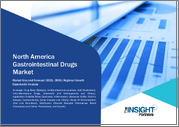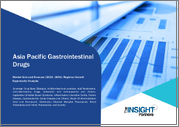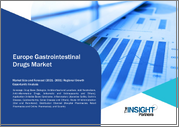
|
시장보고서
상품코드
1593741
위장약 시장 평가 : 약물 종류, 약물 클래스, 투여 경로, 용도, 유통 채널, 지역별 기회 및 예측(2017-2031년)Gastrointestinal Drugs Market Assessment, By Drug Type, By Drug Class, By Route of Administration, By Application, By Distribution Channel, By Region, Opportunities and Forecast, 2017-2031F |
||||||
세계 위장약 시장 규모는 2023년 452억 달러에서 예측 기간 동안 연평균 4.23%의 CAGR로 2031년에는 629억 6,000만 달러로 성장할 것으로 예상됩니다.
소화기 질환 환자 수 증가, 시장 진입 기업들의 신제품 출시, 전 세계 다양한 지역에서 소화기 약품의 가용성 확보에 대한 관심 등이 시장 성장을 견인하는 요인입니다.
약물전달 메커니즘과 제형에 대한 기술 발전으로 소화기 약물의 효능이 향상되고 있습니다. 이러한 발전에는 약물의 생체 이용률과 흡수를 개선하고 환자 결과를 개선하는 서방형 및 지연 방출 제제의 개발이 포함됩니다. 이러한 개발은 궤양성 대장염, 크론병 등의 치료에 혁명을 일으키고 있으며, 시장에 유리한 성장 기회를 제공하고 있습니다.
Celiac disease와 같은 다양한 위장 질환의 유병률 증가도 세계 위장약 시장의 성장을 촉진하고 있으며, 2023년 8월 StatPearls Publishing LLC의 StatPearls 저널에 게재된 기사에 따르면, 체강 질병 유병률은 일반 인구의 약 0.5%-1%입니다. 또한 크론병 환자 수도 빠르게 증가하고 있으며, 미국 국립 당뇨병 및 소화기 및 신장 질환 연구소의 추산에 따르면 미국에서 50만 명 이상이 크론병을 앓고 있는 것으로 나타났습니다. 이에 따라 다양한 제약회사들은 증가하는 크론병의 위협에 대응하기 위한 새로운 치료법 개발을 강화하기 위해 연구 활동에 투자하고 있습니다.
세계 위장약 시장을 조사했으며, 시장 정의와 개요, 시장 규모 추정과 예측, 각종 부문별·지역별·주요 국가별 상세 분석, 산업 구조, 시장 성장에 영향을 미치는 요인 분석, 사례 연구, 경쟁 상황, 주요 기업 개요 등의 정보를 정리하여 전해드립니다.
목차
제1장 프로젝트 범위와 정의
제2장 조사 방법
제3장 주요 요약
제4장 세계의 위장약 시장 전망
- 시장 규모 분석과 예측
- 시장 점유율 분석과 예측
- 약물 유형별
- 약물 클래스별
- 투여 경로별
- 용도별
- 유통 채널별
- 지역별
- 기업별 시장 점유율 분석
- 마켓 맵 분석
제5장 북미의 위장약 시장 전망
- 시장 규모 분석과 예측
- 시장 점유율 분석과 예측
- 국가별 시장 평가
- 미국
- 캐나다
- 멕시코
제6장 유럽의 위장약 시장 전망
- 독일
- 프랑스
- 이탈리아
- 영국
- 러시아
- 네덜란드
- 스페인
- 터키
- 폴란드
제7장 아시아태평양의 위장약 시장 전망
- 인도
- 중국
- 일본
- 호주
- 베트남
- 한국
- 인도네시아
- 필리핀
제8장 남미의 위장약 시장 전망
- 브라질
- 아르헨티나
제9장 중동 및 아프리카의 위장약 시장 전망
- 사우디아라비아
- UAE
- 남아프리카공화국
제10장 수급 분석
제11장 수출입 분석
제12장 밸류체인 분석
제13장 Porter's Five Forces 분석
제14장 PESTLE 분석
제15장 가격 분석
제16장 시장 역학
- 시장 성장 촉진요인
- 시장 과제
제17장 시장 동향·전개
제18장 규제 프레임워크·혁신
제19장 특허 상황
제20장 사례 연구
제21장 경쟁 상황
- 시장 리더 상위 5개사 경쟁 매트릭스
- 상위 5개사 SWOT 분석
- 상위 10개사 상황
- AstraZeneca PLC
- Boehringer Ingelheim International GmbH
- Pfizer Inc.
- Takeda Pharmaceutical Company Limited
- AbbVie Inc.
- Bristol-Myers Squibb Company
- Bayer AG
- Abbott Laboratories
- Johnson & Johnson Services, Inc.(Janssen Global Services, LLC)
- GlaxoSmithKline plc
제22장 전략적 제안
제23장 당사 소개와 면책사항
ksm 24.11.27Global gastrointestinal drugs market is projected to witness a CAGR of 4.23% during the forecast period 2024-2031, growing from USD 45.20 billion in 2023 to USD 62.96 billion in 2031. The market's growth is boosted by the rising cases of gastrointestinal diseases, novel product launches by the market players, and increasing emphasis on ensuring the availability of gastrointestinal drugs in different regions across the globe.
Technological advancements in drug delivery mechanisms and formulations are enhancing the efficacy of gastrointestinal drugs. The advancements include the development of extended-release and delayed-release formulations that aid in improving the bioavailability and absorption of the drugs, resulting in improved patient outcomes. Such developments are revolutionizing the treatment of ulcerative colitis and Crohn's disease, among others, providing lucrative growth opportunities for the market.
The rising prevalence of various gastrointestinal disorders, such as celiac disease, is also propelling the growth of the global gastrointestinal drugs market. According to an article published in the StatPearls journal of StatPearls Publishing LLC in August 2023, the prevalence of celiac disease is approximately 0.5% to 1% among the general population. Additionally, the number of cases of Crohn's disease is also increasing at a rapid rate. According to the estimates of the National Institute of Diabetes and Digestive and Kidney Diseases, more than half a million people are suffering from Crohn's disease in the United States. Thus, various pharmaceutical companies are investing in research activities to augment the development of novel therapies to combat the growing threat of Crohn's disease. In October 2023, Eli Lilly and Company announced that the investigational interleukin-23p19 antagonist, mirikizumab met all major secondary and co-primary endpoints in a phase 3 study, evaluating its efficacy and safety for treating adults with severely to moderately active Crohn's disease.
Increasing Cases of Gastrointestinal Diseases Boost Market Demand
The rising cases of gastrointestinal distress in various regions across the globe due to changes in lifestyle and eating habits of the population is one of the major factors bolstering the global gastrointestinal drugs market demand. Factors such as increased stress and the rising prevalence of obesity are also propelling the incidences of gastrointestinal diseases. According to the estimates of the World Health Organization (WHO), 1 in 8 people around the world were living with obesity in 2022. This increase is augmenting the incidences of diseases such as peptic ulcers, irritable bowel syndrome, and gastroesophageal reflux disease. Furthermore, the rapid expansion of the aging population is also boosting the demand for gastrointestinal drugs as the older population is more susceptible to gastrointestinal issues. The WHO estimates that approximately 1 in 6 people across the globe will be 60 or older by 2030. Due to the rising occurrences of such issues, pharmaceutical companies are also increasingly focusing on developing innovative therapies that address the underlying cause of the disease rather than alleviating symptoms.
Rising Efforts of Pharma Companies Supports Market Expansion
The rising efforts of the key players in the market to ensure the availability of novel gastrointestinal drugs through investments and partnerships is boosting the global gastrointestinal drugs market size. In June 2024, AbbVie Inc. secured its position in the gastrointestinal drugs market by paying USD 150 million to China-based FutureGen Biopharmaceutical (Beijing) Co., Ltd. in near-term fees for rights to antibody drug targeting TL1A molecule that has been linked with a heightened immune response in cases of inflammatory bowel disease.
Similarly, in June 2024, Akum Drugs and Pharmaceuticals Ltd. unveiled new formulations for gastrointestinal diseases for patients in India. The company's Rabeprazole + Levosulpiride SR Capsules received approval from the Drug Controller General of India (DCGI). The drugs aim to provide relief to patients suffering from gastrointestinal tract disorders. Rabeprazole sodium, a potent antisecretory compound, has demonstrated efficacy in treating duodenal and gastric ulcers along with gastroesophageal reflux disease by selectively inhibiting the secretion of gastric acid. Such efforts are expected to aid patients suffering from gastrointestinal issues in effectively managing their conditions and provide lucrative growth opportunities to the gastrointestinal drug market.
Retail Pharmacies Hold Significant Market Share
The segment's expansion can be attributed to the rising requirement for over-the-counter (OTC) gastrointestinal drugs over the past few years due to the rising cases of gastrointestinal distress and consumer preference for immediate relief from common digestive issues, including constipation, acid reflux, diarrhea, and heartburn. As per the American College of Gastroenterology (ACG) estimates, approximately 20% of the population of the United States suffers from gastroesophageal reflux disease. Due to the widespread presence of retail pharmacies and their convenient nature, patients suffering from gastrointestinal issues prefer them for purchasing medication, especially in semi-urban and urban locations.
Meanwhile, online pharmacies are expected to grow rapidly over the next few years due to the growing preference for online shopping, fast delivery, shipping, and the availability of lucrative discounts. Other advantages online pharmacies offer include increased consumer accessibility to a broad range of products. Additionally, the growing popularity of digital consultation and the rising availability of e-prescriptions have also made it easier for patients to avail themselves of the required medications through online pharmacies, bolstering the segment's growth.
North America Holds Major Market Share
The growth of the North American gastrointestinal drugs market can be attributed to the increasing efforts of the leading market players based in the region to ensure novel product launches, rising cases of gastrointestinal diseases, and the presence of well-established healthcare and pharmaceutical sectors. Various gastrointestinal diseases, including ulcerative colitis, Crohn's disease, and inflammatory bowel disease, are becoming increasingly prevalent in the United States, bolstering the market's demand. As per the estimates of the US Centers for Disease Control and Prevention, the prevalence of inflammatory bowel disease is between 2.4 and 3.1 million in the United States, with differing burdens across groups. Additionally, the prominent presence of various research organizations that are increasingly focusing on investigating different gastrointestinal diseases is also expected to influence the market's expansion positively. Moreover, the increasing availability of novel drugs due to the increasing provision of approvals by the regulatory bodies in the region is also supporting the market's growth is the region. In 2023, the US Food and Drug Administration (FDA) provided approval to five new gastrointestinal targeted drugs, including colonoscopy prep, inflammatory bowel disease, and gastroesophageal reflux disease. Such approvals are expected to increase the influx of various gastrointestinal drugs in North America.
Future Market Scenario (2024-2031F)
As per the global gastrointestinal drugs market analysis, the market is expected to witness significant growth in the coming years due to the growing burden of different gastrointestinal diseases and the increasing efforts of the market players towards novel product launches. According to an article published in January 2024 in the Dovepress of the Dove Medical Press Ltd, the prevalence of Crohn's disease is expected to increase to 1% in 2030 in Western European countries and the United States. This increase will bolster the market's demand to meet the growing drug requirement for effective management and treatment of the condition. The cases of gastrointestinal distress are also expected to increase in the coming years due to the increasing preference for fast foods and dining out as a fast food-filled diet lacks essential fiber intake, resulting in decreased adoption of water.
Additionally, the market is also expected to witness significant growth over the forecast period due to the rising investments by the leading pharmaceutical companies towards research and development activities and the emphasis on creating targeted therapies that provide minimal side effects along with long-term relief. Furthermore, the growing efforts of various countries to enhance their healthcare sectors and ensure the availability of necessary therapies and treatment solutions are further expected to propel the global gastrointestinal drugs market growth.
Key Players Landscape and Outlook
The market's growth is bolstered by the rising collaborations by the key players of the market with leading pharma companies across the globe to introduce their products to different countries. In June 2024, Sun Pharmaceutical Industries, Inc. inked a licensing agreement with Takeda Pharmaceutical Company Limited to commercialize their new gastrointestinal drug in India. The former entered into a non-exclusive patent licensing agreement for commercializing Takeda's Vonoprazan tablets, which are 20 and 10 mg in strength and are used for treating reflux esophagitis, among other acid peptic disorders. Such partnerships are expected to aid the market players in expanding their global footprint and demonstrate their commitment to ensuring that healthcare professionals and patients are provided with novel treatment options to manage gastrointestinal diseases and disorders effectively.
Additionally, the key players in the market are also working on introducing novel drugs for managing various gastrointestinal diseases. In June 2024, Johnson & Johnson Services, Inc. submitted a supplemental Biologics License Application (sBLA) to the US FDA to seek approval for TREMFYA, used for treating adults with moderate to severe active Crohn's disease. Such efforts are expected to aid the company in expanding its product portfolio and increasing its market share.
Table of Contents
1. Project Scope and Definitions
2. Research Methodology
3. Executive Summary
4. Global Gastrointestinal Drugs Market Outlook, 2017-2031F
- 4.1. Market Size Analysis & Forecast
- 4.1.1. By Value
- 4.2. Market Share Analysis & Forecast
- 4.2.1. By Drug Type
- 4.2.1.1. Branded
- 4.2.1.2. Generic
- 4.2.2. By Drug Class
- 4.2.2.1. Biologics
- 4.2.2.2. Proton Pump Inhibitors
- 4.2.2.3. Aminosalicylates
- 4.2.2.4. Antacids
- 4.2.2.5. Laxatives
- 4.2.2.6. H2 Antagonists
- 4.2.2.7. Others
- 4.2.3. By Route of Administration
- 4.2.3.1. Oral
- 4.2.3.2. Parenteral
- 4.2.3.3. Rectal
- 4.2.4. By Application
- 4.2.4.1. Ulcerative Colitis
- 4.2.4.2. Irritable Bowel Syndrome
- 4.2.4.3. Crohn's Disease
- 4.2.4.4. Celiac Disease
- 4.2.4.5. Gastroenteritis
- 4.2.4.6. Others
- 4.2.5. By Distribution Channel
- 4.2.5.1. Hospital Pharmacies
- 4.2.5.2. Retail Pharmacies
- 4.2.5.3. Online Pharmacies
- 4.2.6. By Region
- 4.2.6.1. North America
- 4.2.6.2. Europe
- 4.2.6.3. Asia-Pacific
- 4.2.6.4. South America
- 4.2.6.5. Middle East and Africa
- 4.2.7. By Company Market Share Analysis (Top 5 Companies and Others - By Value, 2023)
- 4.2.1. By Drug Type
- 4.3. Market Map Analysis, 2023
- 4.3.1. By Drug Type
- 4.3.2. By Drug Class
- 4.3.3. By Route of Administration
- 4.3.4. By Application
- 4.3.5. By Distribution Channel
- 4.3.6. By Region
5. North America Gastrointestinal Drugs Market Outlook, 2017-2031F*
- 5.1. Market Size Analysis & Forecast
- 5.1.1. By Value
- 5.2. Market Share Analysis & Forecast
- 5.2.1. By Drug Type
- 5.2.1.1. Branded
- 5.2.1.2. Generic
- 5.2.2. By Drug Class
- 5.2.2.1. Biologics
- 5.2.2.2. Proton Pump Inhibitors
- 5.2.2.3. Aminosalicylates
- 5.2.2.4. Antacids
- 5.2.2.5. Laxatives
- 5.2.2.6. H2 Antagonists
- 5.2.2.7. Others
- 5.2.3. By Route of Administration
- 5.2.3.1. Oral
- 5.2.3.2. Parenteral
- 5.2.3.3. Rectal
- 5.2.4. By Application
- 5.2.4.1. Ulcerative Colitis
- 5.2.4.2. Irritable Bowel Syndrome
- 5.2.4.3. Crohn's Disease
- 5.2.4.4. Celiac Disease
- 5.2.4.5. Gastroenteritis
- 5.2.4.6. Others
- 5.2.5. By Distribution Channel
- 5.2.5.1. Hospital Pharmacies
- 5.2.5.2. Retail Pharmacies
- 5.2.5.3. Online Pharmacies
- 5.2.6. By Country Share
- 5.2.6.1. United States
- 5.2.6.2. Canada
- 5.2.6.3. Mexico
- 5.2.1. By Drug Type
- 5.3. Country Market Assessment
- 5.3.1. United States Gastrointestinal Drugs Market Outlook, 2017-2031F*
- 5.3.1.1. Market Size Analysis & Forecast
- 5.3.1.1.1. By Value
- 5.3.1.2. Market Share Analysis & Forecast
- 5.3.1.2.1. By Drug Type
- 5.3.1.2.1.1. Branded
- 5.3.1.2.1.2. Generic
- 5.3.1.2.2. By Drug Class
- 5.3.1.2.2.1. Biologics
- 5.3.1.2.2.2. Proton Pump Inhibitors
- 5.3.1.2.2.3. Aminosalicylates
- 5.3.1.2.2.4. Antacids
- 5.3.1.2.2.5. Laxatives
- 5.3.1.2.2.6. H2 Antagonists
- 5.3.1.2.2.7. Others
- 5.3.1.2.3. By Route of Administration
- 5.3.1.2.3.1. Oral
- 5.3.1.2.3.2. Parenteral
- 5.3.1.2.3.3. Rectal
- 5.3.1.2.4. By Application
- 5.3.1.2.4.1. Ulcerative Colitis
- 5.3.1.2.4.2. Irritable Bowel Syndrome
- 5.3.1.2.4.3. Crohn's Disease
- 5.3.1.2.4.4. Celiac Disease
- 5.3.1.2.4.5. Gastroenteritis
- 5.3.1.2.4.6. Others
- 5.3.1.2.5. By Distribution Channel
- 5.3.1.2.5.1. Hospital Pharmacies
- 5.3.1.2.5.2. Retail Pharmacies
- 5.3.1.2.5.3. Online Pharmacies
- 5.3.1.2.1. By Drug Type
- 5.3.1.1. Market Size Analysis & Forecast
- 5.3.2. Canada
- 5.3.3. Mexico
- 5.3.1. United States Gastrointestinal Drugs Market Outlook, 2017-2031F*
All segments will be provided for all regions and countries covered
6. Europe Gastrointestinal Drugs Market Outlook, 2017-2031F
- 6.1. Germany
- 6.2. France
- 6.3. Italy
- 6.4. United Kingdom
- 6.5. Russia
- 6.6. Netherlands
- 6.7. Spain
- 6.8. Poland
7. Asia-Pacific Gastrointestinal Drugs Market Outlook, 2017-2031F
- 7.1. India
- 7.2. China
- 7.3. Japan
- 7.4. Australia
- 7.5. Vietnam
- 7.6. South Korea
- 7.7. Indonesia
- 7.8. Philippines
8. South America Gastrointestinal Drugs Market Outlook, 2017-2031F
- 8.1. Brazil
- 8.2. Argentina
9. Middle East and Africa Gastrointestinal Drugs Market Outlook, 2017-2031F
- 9.1. Saudi Arabia
- 9.2. UAE
- 9.3. South Africa
- 9.4. Israel
10. Demand Supply Analysis
11. Import and Export Analysis
12. Value Chain Analysis
13. Porter's Five Forces Analysis
14. PESTLE Analysis
15. Pricing Analysis
16. Market Dynamics
- 16.1. Market Drivers
- 16.2. Market Challenges
17. Market Trends and Developments
18. Regulatory Framework and Innovation
- 18.1. Clinical Trials
- 18.2. Regulatory Approvals
19. Patent Landscape
20. Case Studies
21. Competitive Landscape
- 21.1. Competition Matrix of Top 5 Market Leaders
- 21.2. SWOT Analysis for Top 5 Players
- 21.3. Key Players Landscape for Top 10 Market Players
- 21.3.1. AstraZeneca PLC
- 21.3.1.1. Company Details
- 21.3.1.2. Key Management Personnel
- 21.3.1.3. Products and Services
- 21.3.1.4. Financials (As Reported)
- 21.3.1.5. Key Market Focus and Geographical Presence
- 21.3.1.6. Recent Developments/Collaborations/Partnerships/Mergers and Acquisitions
- 21.3.2. Boehringer Ingelheim International GmbH
- 21.3.3. Pfizer Inc.
- 21.3.4. Takeda Pharmaceutical Company Limited
- 21.3.5. AbbVie Inc.
- 21.3.6. Bristol-Myers Squibb Company
- 21.3.7. Bayer AG
- 21.3.8. Abbott Laboratories
- 21.3.9. Johnson & Johnson Services, Inc. (Janssen Global Services, LLC)
- 21.3.10. GlaxoSmithKline plc
- 21.3.1. AstraZeneca PLC
Companies mentioned above DO NOT hold any order as per market share and can be changed as per information available during research work.



















